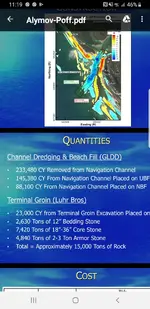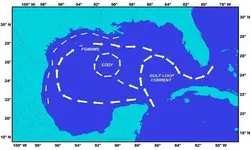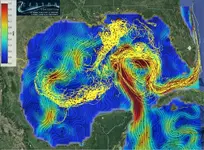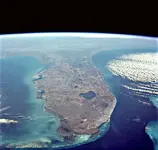You are using an out of date browser. It may not display this or other websites correctly.
You should upgrade or use an alternative browser.
You should upgrade or use an alternative browser.
Seven chests near stump pass
- Thread starter joska
- Start date
Blak bart
Platinum Member
do you guys know how many times operations like this have taken place here over the years ?? Many many times !! Some large some small. There are records that can be found with actual numbers that give the cubic yards moved each time. Just sayin......the numbers are mind blowing. Hundreds of thousands of cubic tons of sand at a time. That's cubic tons....not square tons. Guess these guys can get those chests. If the story of coins being found on the beach here are true......then take a guess how they got there. They sure didn't wash up....they were pumped up many many years ago by army Corp of engineers. Just a little food for thought.
I don't know about treasure on the west coast. I lived in Tampa, Sarasota, Port Charlotte, Punta Gorda, Pine Island and Ft. Myers and hunted all the beaches for years and never found any Spanish coins. So many stories and I bought books telling them all. The Spanish had no reason to go up the West coast with treasure since they were headed to Cuba for Spain...
The Manila Galleons ran up the west coast to and from the Orient to Central America.

Billieg
Sr. Member
- Joined
- Jul 19, 2019
- Messages
- 388
- Reaction score
- 834
- Golden Thread
- 0
- Location
- Deltona Fl
- Detector(s) used
- AT-Pro - Teknetics T2 LTD
- Primary Interest:
- All Treasure Hunting
When I lived in Sarasota I took my boat to stump pass many times with the detector. I searched most of what you see in your pic. the only thing I found worth while was a 1852 dime.
Billieg
Sr. Member
- Joined
- Jul 19, 2019
- Messages
- 388
- Reaction score
- 834
- Golden Thread
- 0
- Location
- Deltona Fl
- Detector(s) used
- AT-Pro - Teknetics T2 LTD
- Primary Interest:
- All Treasure Hunting
Sorry double post
The Manila Galleons ran up the west coast to and from the Orient to Central America.
Oh I misread that. You meant West coast of Florida. Haha.
Billieg
Sr. Member
- Joined
- Jul 19, 2019
- Messages
- 388
- Reaction score
- 834
- Golden Thread
- 0
- Location
- Deltona Fl
- Detector(s) used
- AT-Pro - Teknetics T2 LTD
- Primary Interest:
- All Treasure Hunting
The Manila Galleons ran up the west coast to and from the Orient to Central America.
That makes about as much sense as driving to Miami from Tampa via New Orleans.....
Bum Luck
Silver Member
Ok, here is a map of their routes. Where do you see them coming close to the west Fl. beaches?
View attachment 1735925
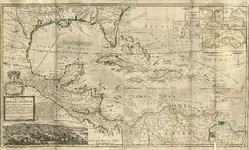
Of course, the ships that stayed away from the beaches didn't end up on them.
Last edited:
Salvor6
Silver Member
- Joined
- Feb 5, 2005
- Messages
- 3,760
- Reaction score
- 2,181
- Golden Thread
- 0
- Location
- Port Richey, Florida
- Detector(s) used
- Aquapulse, J.W. Fisher Proton 3, Pulse Star II, Detector Pro Headhunter, AK-47
- Primary Interest:
- Shipwrecks
Billieg the chart you posted is a generic version showing the general direction of the fleets. It is NOT the actual sailing routes they took. Look at the chart Bum Luck posted. Does it look anything like yours? Is the chart you posted an actual sailing route chart from the 16th century archives? How else would you explain the wrecks at Padre island, TX, Cedar Key and Sanibel Island, FL? They followed the coast for three reasons. First, the prevailing winds took them in that direction. Second, there is a current in the Gulf called the "Loop Current" that gave their ships an extra 2 knots speed. Third, they used the shore to know exactly where they were at any time.
Last edited:
Jay Plunder
Full Member
- Joined
- Aug 18, 2009
- Messages
- 116
- Reaction score
- 153
- Golden Thread
- 0
- Location
- Southeastern, NC
- Detector(s) used
- Garrett AT Pro
- Primary Interest:
- All Treasure Hunting
Is the old Stump Inn near Stump Pass? I was once told about a mishap by someone looking for it near a place where lovers are known to park.
OMG I can't stop laughing!
- Joined
- Aug 19, 2014
- Messages
- 38,960
- Reaction score
- 143,432
- Golden Thread
- 0
- Location
- Tarpon Springs
- Detector(s) used
- JW 8X-ML X2-VP 585
- Primary Interest:
- All Treasure Hunting
Billieg the chart you posted is a generic version showing the general direction of the fleets. It is NOT the actual sailing routes they took. Look at the chart Bum Luck posted. Does it look anything like yours? Is the chart you posted an actual sailing route chart from the 16th century archives? How else would you explain the wrecks at Padre island, TX, Cedar Key and Sanibel Island, FL? They followed the coast for three reasons. First, the prevailing winds took them in that direction. Second, there is a current in the Gulf called the "Loop Current" that gave their ships an extra 2 knots speed. Third, they used the shore to know exactly where they were at any time.
Isn't it rather funny how's it that guys like us understand what historians generally overall have not.
I laugh at some of the "route" maps made by some of them that exist out there. heh
- Joined
- Aug 19, 2014
- Messages
- 38,960
- Reaction score
- 143,432
- Golden Thread
- 0
- Location
- Tarpon Springs
- Detector(s) used
- JW 8X-ML X2-VP 585
- Primary Interest:
- All Treasure Hunting
Billieg
Sr. Member
- Joined
- Jul 19, 2019
- Messages
- 388
- Reaction score
- 834
- Golden Thread
- 0
- Location
- Deltona Fl
- Detector(s) used
- AT-Pro - Teknetics T2 LTD
- Primary Interest:
- All Treasure Hunting
Looking at the currents, one can surmise the route..
View attachment 1739750 View attachment 1739752
Thank you. As you can see the closest they would have gotten to FL W. coast was hundreds of miles looking at your map. Naples would have been the closest. Maybe during a hurricane they could have blown into Sanibel but that wasn't their main route. I lived on Pine Island in back of Sanibel and fished and detected Sanibel, Punta Gorda, Venice, Sarasota etc. for years and never heard of any Spanish ships found off the shore.
- Joined
- Aug 19, 2014
- Messages
- 38,960
- Reaction score
- 143,432
- Golden Thread
- 0
- Location
- Tarpon Springs
- Detector(s) used
- JW 8X-ML X2-VP 585
- Primary Interest:
- All Treasure Hunting
Thank you. As you can see the closest they would have gotten to FL W. coast was hundreds of miles looking at your map. Naples would have been the closest. Maybe during a hurricane they could have blown into Sanibel but that wasn't their main route. I lived on Pine Island in back of Sanibel and fished and detected Sanibel, Punta Gorda, Venice, Sarasota etc. for years and never heard of any Spanish ships found off the shore.
Just because you have never heard of any does not mean there isn't any.
I will share with you all here... MY facts on this topic / matter...
The Spanish have been all over the west coast of Florida LONG before anywhere else in North America... the first expeditions in recorded history were ALL on the west coast... the West Coast of Florida was a hot bed of Spanish activity throughout Florida's beginnings... from the very first landings to the very first settlement / colony.
AND... unlike depicted on that map and dozen's of others... the routes WERE along the coastline... WITHIN site of land... NOT in open water off sight of land.
Period.
What I say is based on years of intense research. (And theory must not contradict empirical facts).
Now... as far as Spanish wrecks on the West Coast of Florida is concerned...They exist...
and the reason you will never hear of them is due to many factors... ONE and foremost being... anything from that period would be under a minimum of 10 feet of sand... and in most cases the depth of sand would be more in the range of 20+ feet of sand.
This is due to the constant coastal changes the West Coast Of Florida has sustained over eons.
I saw a wreck once... (origin unknown) only once... after a major storm... within days it was gone again.
I can tell you story after story I know.
And besides... you have to know where to look

Last edited:
Red_desert
Gold Member
- Joined
- Feb 21, 2008
- Messages
- 7,145
- Reaction score
- 3,786
- Golden Thread
- 0
- Location
- Midwest USA
- Detector(s) used
- Garrett Ace 250/GTA 1,000; Fisher Gold Bug-2; Gemini-3; Unique Design L-Rods
- Primary Interest:
- All Treasure Hunting
Don't forget the pirates were quite busy on Florida W coast.
- Joined
- Aug 19, 2014
- Messages
- 38,960
- Reaction score
- 143,432
- Golden Thread
- 0
- Location
- Tarpon Springs
- Detector(s) used
- JW 8X-ML X2-VP 585
- Primary Interest:
- All Treasure Hunting
Don't forget the pirates were quite busy on Florida W coast.
Correct Red D...
And "busy" would be an understatement actually... more like "infested" would fit better..

And this was the case until the late 1850's.
Red_desert
Gold Member
- Joined
- Feb 21, 2008
- Messages
- 7,145
- Reaction score
- 3,786
- Golden Thread
- 0
- Location
- Midwest USA
- Detector(s) used
- Garrett Ace 250/GTA 1,000; Fisher Gold Bug-2; Gemini-3; Unique Design L-Rods
- Primary Interest:
- All Treasure Hunting
[h=2]The Spanish King's Finest Jewel--Bayou Chico on the Bay of Pensacola[/h]
ArcheologyInk | Pensacola's Archeology Journal | ?The Spanish King?s Finest Jewel?: Bayou Chico on the Bay of Pensacola | ArcheologyInk
Red_desert
Gold Member
- Joined
- Feb 21, 2008
- Messages
- 7,145
- Reaction score
- 3,786
- Golden Thread
- 0
- Location
- Midwest USA
- Detector(s) used
- Garrett Ace 250/GTA 1,000; Fisher Gold Bug-2; Gemini-3; Unique Design L-Rods
- Primary Interest:
- All Treasure Hunting
In the shallow waters of Chico Bayou Pensacola, in August of 1913, Charles H Villar of Pensacola found a Spanish treasure chest filled with gold doubloons and pieces of eight pre-dating the 1800s.
Similar threads
- Replies
- 2
- Views
- 434
- Replies
- 6
- Views
- 560
Users who are viewing this thread
Total: 1 (members: 0, guests: 1)
Latest Discussions
-
-
-
Garrett Vortex VX9 potential major flaw(s) with latest version software
- Latest: tnsharpshooter
-



